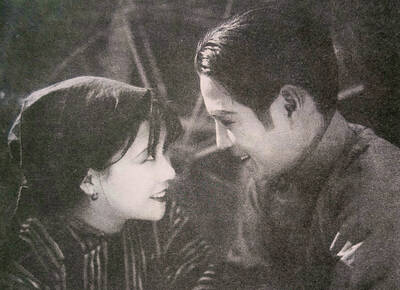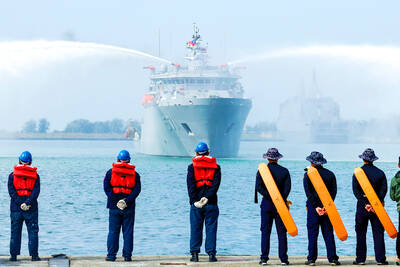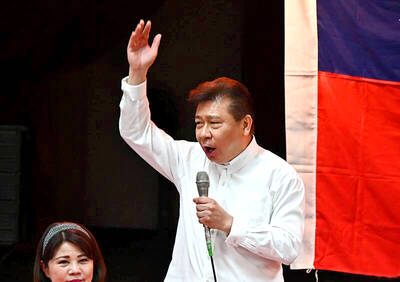The Battle of Red Cliff is an event known to every Chinese school student, not just as an encounter that altered history, but as a story that defines all manner of human virtue and vice. The National Palace Museum’s exhibition A Thousand, Thousand Churning Waves: The Legendary Red Cliff Heritage (捲起千堆雪 — 赤壁文物特展) looks back over some of the works, both in literature and in the visual arts, that helped define this millennia-old conflict as part of a Chinese national consciousness.
The exhibition, which runs until Aug. 31, mainly consists of calligraphy, books and paintings. Many of them are beautiful, but their significance is often buried deep in the notes that accompany each piece. To endow these scholarly items with greater dynamism, the museum has launched a series of artistic and educational activities that will take place in conjunction with the exhibition. The most elaborate component is the staging of two outdoor performances, one tonight and one on June 20, of theatrical pieces that feature characters who took part in the great battle.
The two performances, by the Beijing opera troupe of the National Guoguang Opera Company (國立國光劇團) and by puppetmaster Huang Chun-hsiung (黃俊雄), show that the story of Red Cliff remains very much a living part of Chinese traditional arts.
Like Agincourt or Waterloo, the figures in the battle lines on either side are more than dusty characters from the past. They have been turned into living embodiments of a cultural and moral consciousness. In recent years, comic books and video games have introduced the characters of the story to the young, and recently, the popularity of the story has been given a further boost by John Woo’s (吳宇森) massive star-studded two-part epic, Red Cliff (赤壁). The second installment was released in Taiwan at the beginning of this year.
Linking the National Palace Museum’s academic might with a topic that is so closely connected with popular culture seemed to be a winning idea. It was, therefore, disconcerting to hear the show’s chief curator, Lin Tien-jen (林天人), eagerly disowning any association with the popular expressions of interest in the story. That he might not want his serious and painstaking research undermined is understandable, but the determinedly scholarly presentation of the show runs counter to many major museums’ efforts to create exhibitions that wear their scholarship more lightly in an effort to foster a broader appeal.
For an audience familiar with the history of the Three Kingdoms and the works of literature that brought it to life, the exhibition has some astonishing treasures, not least a Sung Dynasty scroll by the poet Su Shi (蘇軾) of the Former Ode on Red Cliff (前赤壁賦), which helped turn the Battle of Red Cliff into a potent literary symbol both of the splendor of great ambition and of the impermanence of all man’s work.
Lin sees this work as a major milestone in the establishment of Red Cliff as a literary theme. The other side of the exhibition looks at the historical and practical aspects of the battle, with exhibits including a Sung Dynasty copy of pages from Sun Zi’s Art of War (孫子兵法) as annotated by Cao Cao (曹操), a major protagonist whose ambitions to bring southern China under his sway were scuppered at the Battle of Red Cliff. Then there are the illustrated books, the comics of former centuries, shown alongside learned speculation from ancient scholars about mundane aspects of archaic warfare in treatises such as the delightfully abstruse Description of the Machinery and Implements Employed on Rivers (河工器具圖說), an academic work from the Qing Dynasty.
Lin believes that his achievement in organizing this exhibition is to break out from the confines of an actual historical event and look at perceptions of it over many centuries. “The exhibition is not caught up in the events of 208 (when the battle was fought). It starts there, in the earth-shattering battle, then it becomes a topic from which artists and poets drew inspiration, and finally into a popular story known by all. I am looking at how the idea of Red Cliff developed through history and art,” Lin said.
The exhibition itself fails to update this iconography by not relating ancient artifacts to recognizable characters such as Tony Leung Chiu Wai (梁朝偉) and Takeshi Kaneshiro (金城武), who both play major parts in Woo’s movie. From the perspective of foreign visitors to the museum, who may well have at least heard about the Battle of Red Cliff as a result of the significant publicity for Woo’s films, the exhibition tantalizes, but offers little to draw them deeper into the subject.
The museum has attempted to make good this deficiency by staging a program of educational activities and performances, but the opportunity to build this kind of accessibility into the exhibition itself is wasted.
The desire to be enlightened about subjects of popular appeal can be seen from the fact that a Parents and Children DIY class (scheduled for June 21), which includes a special guided tour of the exhibition and various hands-on activities, is already full. Two further DIY activities aimed at families are scheduled for July 5 and July 15 (online bookings can be made at tech2.npm.gov.tw/signup/frontend/index.asp). An online educational game has also been designed for children (tech2.npm.gov.tw/98events/redcliffgame).

March 10 to March 16 Although it failed to become popular, March of the Black Cats (烏貓進行曲) was the first Taiwanese record to have “pop song” printed on the label. Released in March 1929 under Eagle Records, a subsidiary of the Japanese-owned Columbia Records, the Hoklo (commonly known as Taiwanese) lyrics followed the traditional seven characters per verse of Taiwanese opera, but the instrumentation was Western, performed by Eagle’s in-house orchestra. The singer was entertainer Chiu-chan (秋蟾). In fact, a cover of a Xiamen folk song by Chiu-chan released around the same time, Plum Widow Missing Her Husband (雪梅思君), enjoyed more

Last week Elbridge Colby, US President Donald Trump’s nominee for under secretary of defense for policy, a key advisory position, said in his Senate confirmation hearing that Taiwan defense spending should be 10 percent of GDP “at least something in that ballpark, really focused on their defense.” He added: “So we need to properly incentivize them.” Much commentary focused on the 10 percent figure, and rightly so. Colby is not wrong in one respect — Taiwan does need to spend more. But the steady escalation in the proportion of GDP from 3 percent to 5 percent to 10 percent that advocates

From insomniacs to party-goers, doting couples, tired paramedics and Johannesburg’s golden youth, The Pantry, a petrol station doubling as a gourmet deli, has become unmissable on the nightlife scene of South Africa’s biggest city. Open 24 hours a day, the establishment which opened three years ago is a haven for revelers looking for a midnight snack to sober up after the bars and nightclubs close at 2am or 5am. “Believe me, we see it all here,” sighs a cashier. Before the curtains open on Johannesburg’s infamous party scene, the evening gets off to a gentle start. On a Friday at around 6pm,

A series of dramatic news items dropped last month that shed light on Chinese Communist Party (CCP) attitudes towards three candidates for last year’s presidential election: Taiwan People’s Party (TPP) founder Ko Wen-je (柯文哲), Terry Gou (郭台銘), founder of Hon Hai Precision Industry Co (鴻海精密), also known as Foxconn Technology Group (富士康科技集團), and New Taipei City Mayor Hou You-yi (侯友宜) of the Chinese Nationalist Party (KMT). It also revealed deep blue support for Ko and Gou from inside the KMT, how they interacted with the CCP and alleged election interference involving NT$100 million (US$3.05 million) or more raised by the